As Dr. Haddon has pointed out, the familiar game of cat's-cradle probably had its origin in Asia whence it was introduced into Europe; it has also spread to some extent among the Asiatic islands. It is well known in China, Korea, Japan, the Philippines and Borneo; and it may be known in Java, Celebes, and Australia. It is apparently unknown in Micronesia, Melanesia, Polynesia, and to the Amerinds. In Europe it is recorded from Austria, Germany, the Netherlands, Denmark, Sweden, Switzerland, France, and England. From France it has spread into Northern Africa, for Dr. W. H. Furness found several little Arab girls in the tapestry school in Algiers who played it exactly as we do; they learned it in a French school. Of course it is probably known in all parts of the world which have felt the influence of European culture.
We have not been able to find any record of the time or manner of its introduction into England, but this must have happened within comparatively recent years as there are no references to it in the older literature. Moreover, no satisfactory explanation of the name "cat's-cradle" has ever been given; its other name, "cratch-cradle," may refer to the two important stages of the game: the "manger" (a cratch) and the "cradle."
In Southern China cat's cradle is known as Kang sok = Well rope; in Swatow the name means "Sawing wood." In Korea it is called Ssi-teu-ki = Woof-taking; and in Japan, Aya ito tori = Woof pattern String-taking. In Germany it has various names: Abheben = Taking-off, Faden-abheben = Taking-off strings, Fadenspiel = String game, Hexenspiel = Witch's game, and Auf- und Abnehmen = Picking-up and taking-off. In Holland it is known as Afpakken : Dradenspel = Taking-off : String game; in France and Algeria as la scie.
Two persons and one loop of string are required for the game of "Real Cat's-Cradle," which is played by the persons alternately taking the string off each other's hands to produce eight definite figures which have been given distinctive names, as follows: 1, Cradle; 2, Soldier's Bed; 3, Candles; 4, Manger; 5, Diamonds; 6, Cat's Eye; 7, Fish in a Dish; 8, Clock. For convenience in describing the game the players will be called "A" and "B." The terms "near," "far," "right," and "left" describe the position of the strings as seen by the person from whose hands the figure is being taken.
Synonyms
- Pa-tok-hpan
- chess board (Korea)
- nekomata
- a mountain cat into which a domestic cat is supposed to transform itself (Japan)
- die Schere (Brabent)
- les ciseaux (France)
- church window (England)
- fish pond (America)
"B" puts his left thumb away from "A" under the right near middle finger string and his left index away from "A" under the left near middle finger string, and then, by bringing the thumb and index together, picks up between their tips the two near middle finger strings just where they cross at the near side of the figure. In the same manner he picks up the two far middle finger strings, by putting the right thumb toward "A" under the right far middle finger string, and the right index toward "A" under the left far middle finger string, then bringing the thumb and index together to hold the two strings where they cross at the far side of the figure. Now separating his hands, drawing the right hand away from "A" and the left hand toward "A" (Fig. 742) he carries the thumb and index of each hand, still holding the strings, around the corresponding side string of the figure and up into the centre of the figure (Fig. 743); then by drawing his hands apart and separating the index fingers widely from the thumbs he removes the figure from "A's" hands and extends the "Soldier's Bed" (Fig. 744). There is a loop on each thumb, a loop on each index, and a string passing across the backs of the thumb and index of each hand. The figure is formed of the four finger loops crossing in the middle, a straight near string and a straight far string.
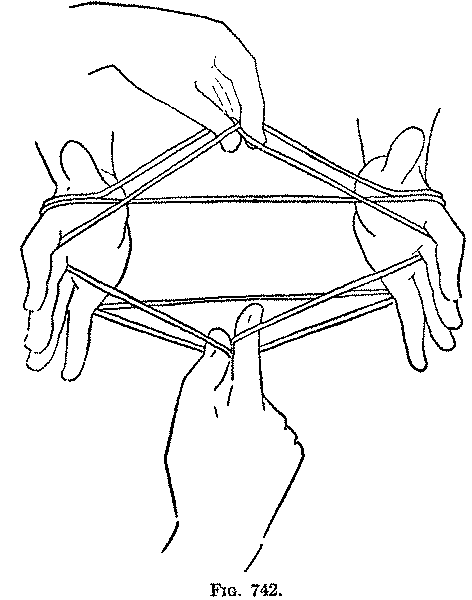
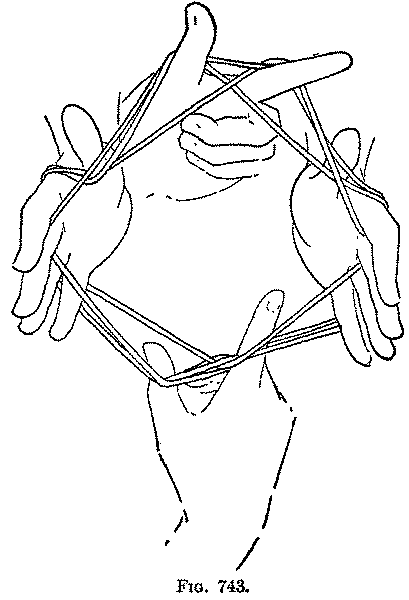

String Figure Notation (SFN)
- B: TF gr 2XS, TF pu n&fSS: re S from A's H
Synonyms
- Tjye-ka-rak
- chopsticks (Korea)
- Koto
- a musical instrument (Japan)
- geta no ha
- the two pieces of wood under the sole of clogs (Japan)
- mirror (Denmark)
- les chandelles (France)
- die Geige (Brabent)
"A" inserts his left index from above into the left thumb loop, near the centre of the figure, and his left thumb from above into the right thumb loop and then, bringing the thumb and index together, picks up between their tips the near thumb strings just where they cross. In like manner, by inserting the right thumb from above into the right index loop and the right index from above into the left index loop, he picks up the two far index strings where they cross. He then separates the hands—drawing the right hand away from "B" over, and past, the far straight string, and the left hand toward "B" over, and past, the near straight string (Fig. 745); and finally puts the thumb and index of each hand (still holding the strings) under the corresponding side string and from below into the centre of the figure, when, by drawing the hands apart and separating the index fingers widely from the thumbs he takes the figure from "B's" hands (Fig. 746). There is a loop on each thumb, a loop on each index, and a string passing across the backs of the thumb and index of each hand; the "Candles" being formed by a straight single far thumb string, a straight single near index string, and straight double far index and near thumb strings.
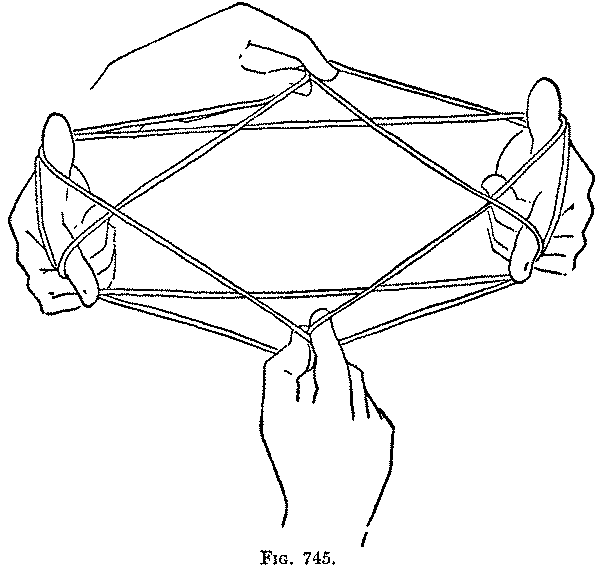
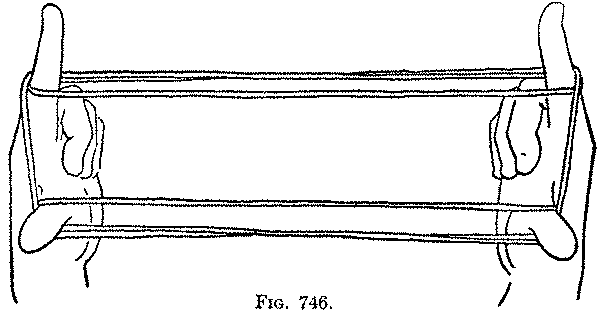
String Figure Notation (SFN)
- A: TF md-th TLN gr XS, TF mu-pu n&fSS
Synonyms
- the inverted cradle (England)
- die Wiege (Brabent)
"B" turns his left hand with the palm facing upward, and takes up in the bend of the little finger the near index string, and draws it over the strings toward "A"; then turning his right hand with the palm up he takes up in the bend of the right little finger the far thumb string, and draws it over the other strings away from "A" (Fig. 747). Closing the little fingers on the palms, he passes the left thumb and index from the near side under the two near thumb strings and up on the far side of them, and at the same time passes the right thumb and index from the far side under the two far index strings and up on the near side of them (Fig. 748). Then, drawing the hands apart, and separating the index fingers widely from the thumbs, he takes the figure from "A's" hands (Fig. 749). He now has two strings passing across the backs of the thumb and index of each hand and a loop held to the palm by each little finger. The form of the "Manger" is the same as that of the "Cradle" only inverted.
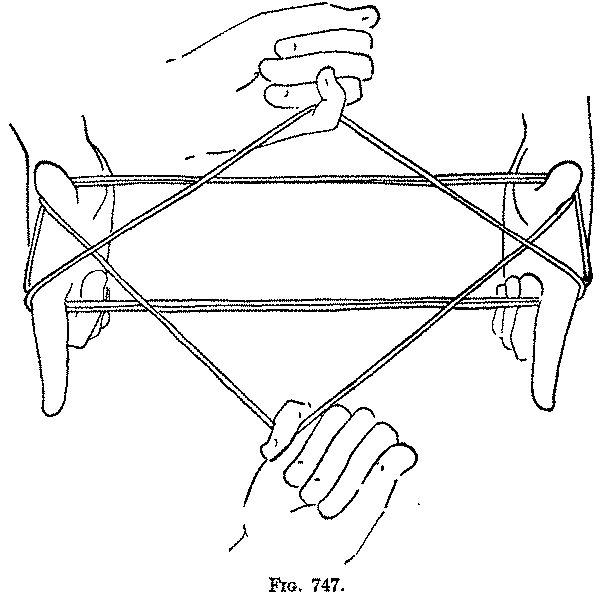
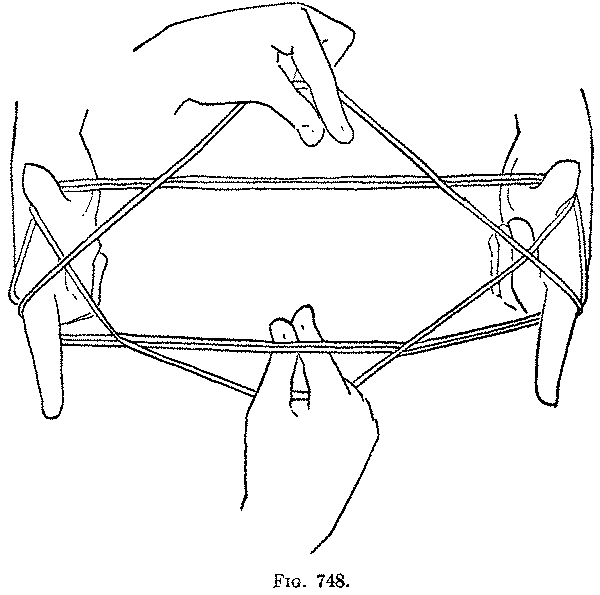
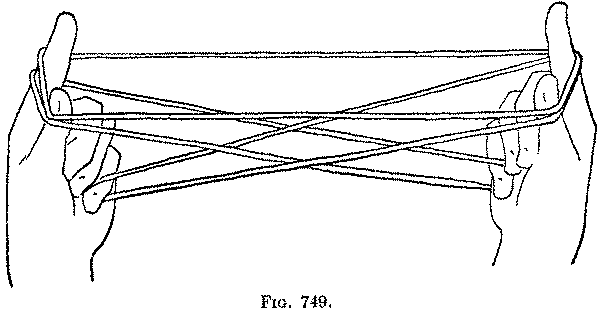
String Figure Notation (SFN)
- B: L mo FS gr fTS, ex: other L gr nFS, TF mu-pu n&fSS
Synonyms
- Soldier's Bed again (England)
- les carreaux (France)
"A" now takes the "Manger" from "B's" hands in the same way as "B" took the "Cradle" from his hands, but the thumb and index of each hand (holding between their tips the two crossed strings) are brought up around the corresponding side string and down into the centre of the figure (Fig. 750); then, when the hands are drawn apart and the thumbs and index fingers widely separated, he forms a figure exactly like the "Soldier's Bed" but it is held with the fingers pointing downward (Fig. 751).
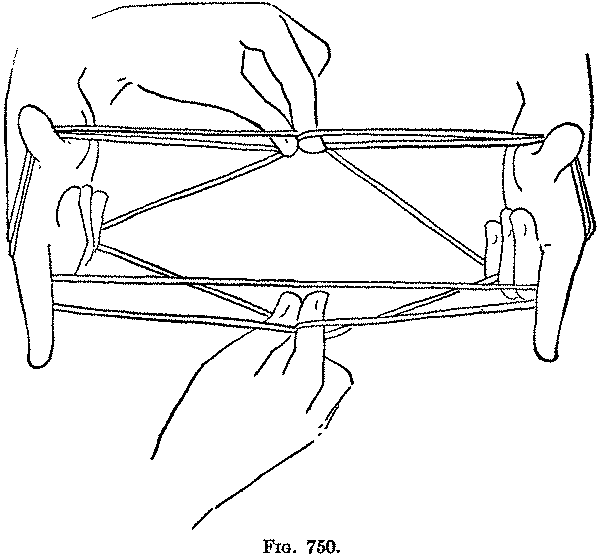

String Figure Notation (SFN)
- A: TF mu-gr 2XS, TF mo-pu n&fSS
Synonyms
- Soi-noun-kal
- Cow's Eyeball (Korea)
- umano me
- Horse-eye (Japan)
- diamonds (England)
"B" takes the figure from "A's" hand in the same way as "A" took the "Soldier's Bed" from "B" to form the "Candles" (Fig. 752); but, although he has a loop on each thumb, a loop on each index, and a string passing across the backs of both thumb and index, instead of getting the same figure as the "Candles," the "Cat's Eye" (Fig. 753) has two straight near thumb strings, two straight far index strings and crossed far thumb and near index strings forming a central lozenge and four triangles, produced by the thumb and index loops, which may be called the near and far right, and near and far left triangles.
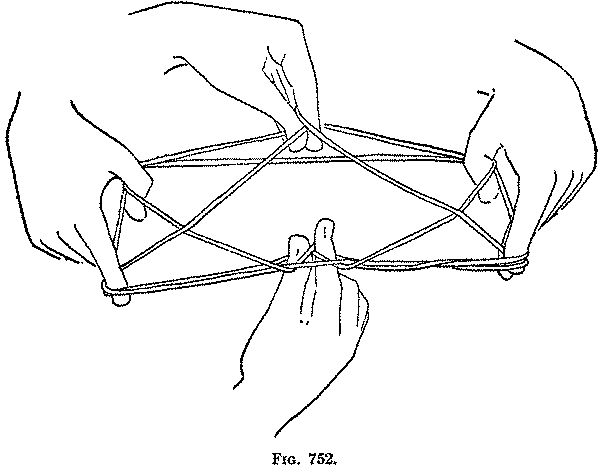
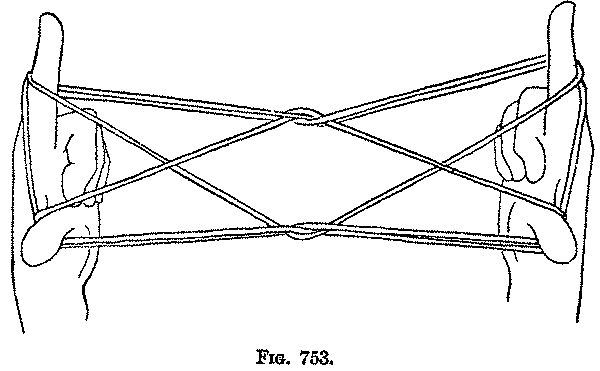
String Figure Notation (SFN)
- A: TF md-th TLN gr XS, TF mu-pu n&fSS
Synonyms
- Tjyel-kou-kong-i
- Rice-mill Pestle (Korea)
- tsuzumi
- A Musical Instrument (Japan)
"A" inserts the right index from above into the far left triangle, and his right thumb from above into the far right triangle, his left index from above into the near left triangle and his left thumb from above into the near right triangle; then turning the thumbs and index fingers up into the central lozenge (Fig. 754), he draws his hands apart, separates the index fingers widely from the thumbs, and takes the figure from "B's" hands (Fig. 755). The "Fish in a Dish" consists of a large central lozenge, divided lengthwise by two straight strings; and right and left near and far triangles. There is a loop on each thumb and a loop on each index, but no string passing across the backs of both thumb and index.
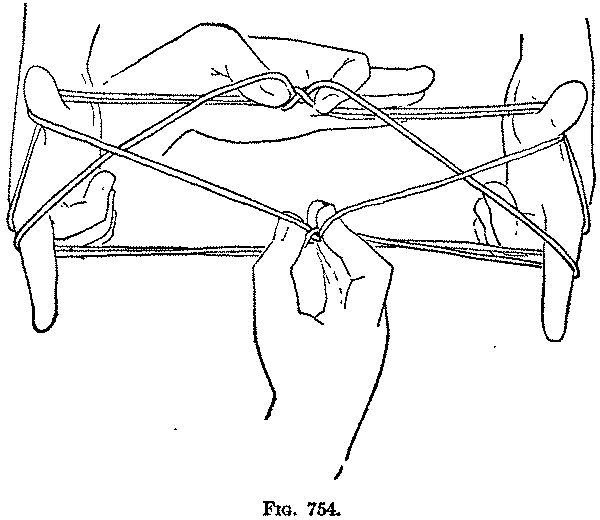
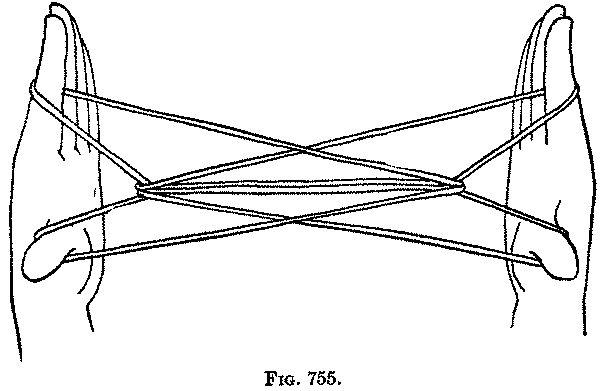
String Figure Notation (SFN)
- B: TF gr 2 cDS near A's TFS mu-pu DS
My father, Dr. Horace Howard Furness, tells me that as a child he ended the game of Cat's-cradle by forming the "Clock" from the "Fish in a Dish," in the following manner:
First: "B" arranges the two strings which pass from side to side through the central lozenge so that, uncrossed, they can easily be separated into a near string and a far string.
Second: "B" now turns his left hand with the palm facing upward, and picks up in the bend of the left little finger the near string which passes through the central lozenge, and draws it over the other strings toward "A" ; then turning the right hand with the palm facing upward he picks up in the bend of the right little finger the far string which passes through the central lozenge, and draws it over the other strings away from "A" (Fig. 756). Putting the right thumb from above into the right far triangle, the right index from above into the left far triangle, the left thumb from above into the right near triangle, and the left index from above into the left near triangle, "B" turns the thumb and index of each hand toward the centre of the figure and up into the central lozenge (Fig. 757), when, by drawing the hands apart, and separating the thumbs widely from the index fingers, he takes the figure from "A's" hands (Fig. 758).
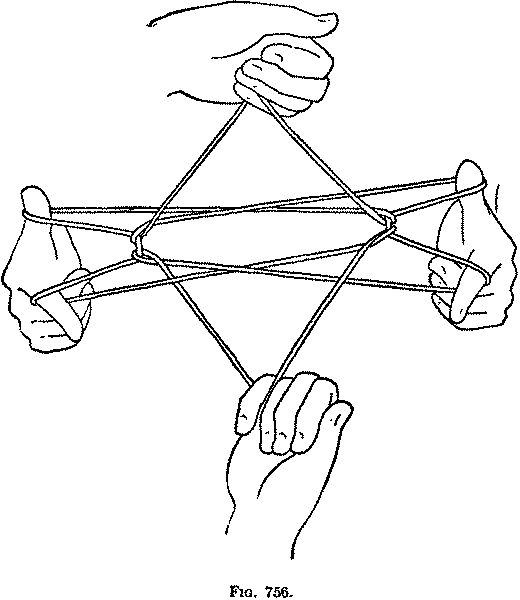
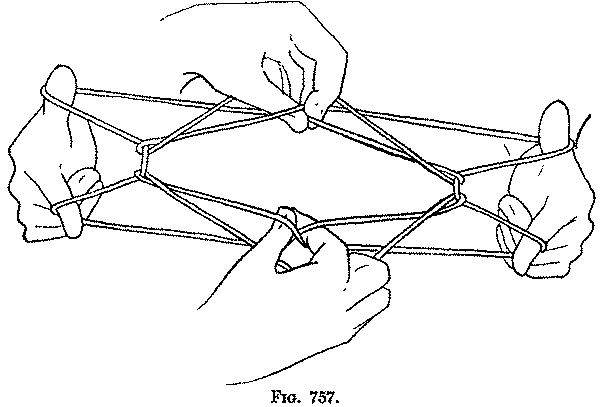
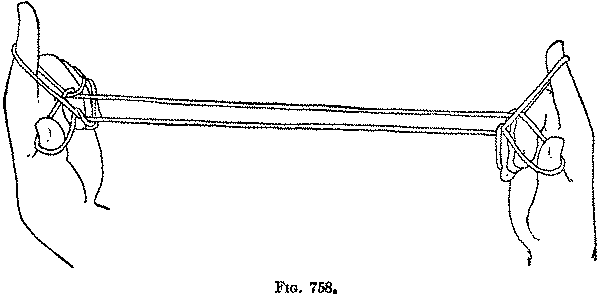
When the figure is held vertically it is supposed to represent a tall clock.
The "Real Cat's-cradle" is capable of some variation: The Philippine Linao Moros at the St. Louis Exposition always passed from the (6) "Cat's Eye" back to the (4) "Manger" without any intervening steps, as follows: The "Cat's Eye" is on "A's" hands. "B" picks up in the bend of his right little finger the string which passes between "A's" left thumb and index, and lifts that string off "A's" left index only; in like manner he picks up in the bend of his left little finger the string which passes between "A's" right thumb and index, and lifts that string off "A's" right thumb only; then, still holding each string in the bend of the little finger, "B" puts his right thumb and index (held close together) down into the figure, near "A's" left hand, and then up into the central lozenge, and thus picks up from below on these fingers the crossed strings of that side; in the same way "B" puts his left thumb and index down near "A's" right hand and then up into the central lozenge, and thus picks up from below on these fingers the crossed strings of that side. The figure is now taken off "A's" hands and extended as the "Manger." This may be the way that the Koreans, according to Dr. Weir, pass from the (6) "Cat's Eye" to the (3) "Candles." Apparently the Japanese and Koreans pass from the (3) "Candles" to the (6) "Cat’s Eye" (see Culin, 2, p. 30), but I do not know how it can be done without an intervening figure. It is possible to jump from the (1) "Cradle" to the (3) "Candles" by picking up the crossed strings as if for the "Soldier's Bed," but putting the fingers down into the figure, and separating the hands; then the "Candles" are held of course with the fingers pointing downward. We can pass directly from the (2) "Soldier's Bed" to the (6) "Cat's Eye" by picking up the crossed strings from below, bringing them around the side strings and down into the centre of the figure, and then separating the hands.